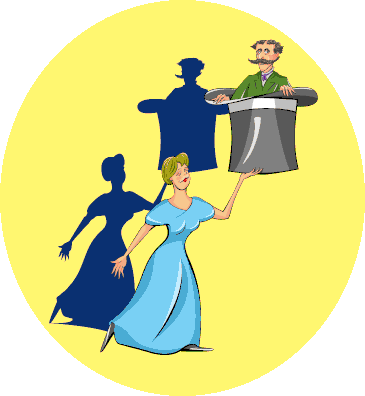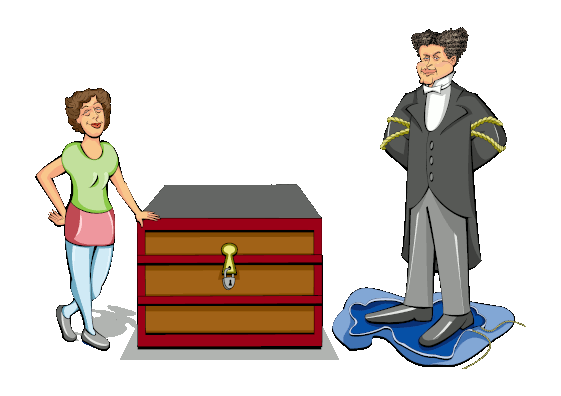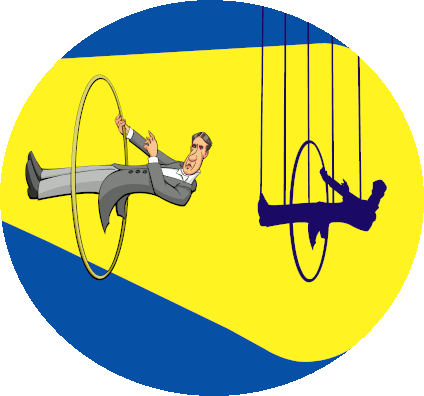THE GREAT
Alexander and Adelaide
HERRMANN

(Click to zoom in and out.)
| "The most radical development in conjuring in the present century is the series of sensational escapes which have been devised or developed by Houdini." | |
| ‐ | Harry Houdini, "Conjuring", Encyclopedia Britannica, 1926. |
In this famous and anonymously written article on the history of conjuring and stage magic, Harry Houdini mentioned only two performing magicians. One was Hugh Simmons Lynn who had toured during the early 19th century. Harry mentioned "Doctor" Lynn once.1
Footnote
The mention of Dr. Lynn leads to the speculation that Harry may have seen one his shows which fired the young Erie Weiss's interest in magic. Dr. Lynn - who's real name was Hugh Washington Simmons - began performing professionally in 1861. He performed first in Australia and then sailed to the American West Coast. Among those who attended Dr. Lynn's performances was Brigham Young where the story was that after Dr. Lynn's troup moved on, Brigham went to the tabernacle to thank the Lord that the devil had left town. Lynn's son, J. Wellesley Lynn, also became a magician.
The other magician Harry mentioned was - who else? - Harry Houdini - who he cited four times in the 700 world article.
Since Harry had no hesitation in devoting much of an article on the history of stage illusion to himself, it's understandable he had little room for his contemporaries and competitors like Howard Thurston or Harry Blackstone. But Harry also passed over some of the true founders of modern performing magic: Bartholomew Bosco, Johann Liebholz, Auguste-Joseph Cohen, Johann Hofzinser, Hartwig Seeman, Charles Arbre, and even the Great Harry Kellar or John Nevil Maskelyne (who also invented the pay toilet). And he certainly should have mentioned Jean-Eugène Robert-Houdin who is regarded as the founder of modern performance magic.2
Footnote
Although originally an admirer of Robert Houdin - from whom Harry borrowed his stage name - when the magician's wife and daughter refused to meet with him, Harry went into a spittle flinging tirade against Houdin, claiming he wasn't so hot after all. He vented his spleen in his book The Unmasking of Robert-Houdin where he claims Robert's tricks were taken from earlier performers. The book, although not without merit, is not regarded as a fair-minded appraisal of Robert Houdin's contributions to modern conjuring.
So we probably shouldn't be surprised that Harry omitted Alexander Herrmann who in the last part of the 19th century toured for more than 25 years. He traveled throughout America with a full evening show which promised wonders the likes of which the audience had never seen. Officially Adeliade took the place of the omnipresent female magician's assistant who adorn the act with a maximum of beauty and a minimum of clothes. But she was actually a skilled magician in her own right as events would later show.
The truth is that many of the magician's assistants are and must be adept at the tricks. Harry's wife, Bess, performed the famous "Metamorphosis" trick where the bound and cuffed magician is tied into a sack and placed in a locked trunk and quickly changes place with his assistant. The trick can be worked either way so that who is the magician and who is the assistant is a matter of semantics. Also some of Harry's handcuff's escapes largely relied more on sleight of hand than agility and strength. During the brouhaha on stage, Bess could slip Harry a lock pick or a filed key.

The Houdinis
In a profession were les noms des scène are almost de rigueur, Alexander Herrmann's real name was - Alexander Herrmann. He was born in Paris in 1844 into a performing family. His dad was a practicing conjurer (as well as a physician) and his older brother, Compars, quit his own medical studies to become an illusionist while Alexander joined the act as his assistant.
After some time, Alexander decided the European stage was getting a bit crowded with conjuring Herrmanns, so he moved to America and by late 1869 notices were appearing in the great metropolitan newspapers about the amazing "professor" from Europe. Evidently Herrmann liked America and he became a naturalized citizen in 1876.

Howard Thurston
He saw Herrmann.
Although there is doubt that Harry Houdini actually saw Dr. Lynn perform rather than one of Lynn's imitators, we do know that a young man from Columbus, Ohio, named Howard Thurston saw Alexander Herrmann. Herrmann's act inspired Howard to learn sleight-of-hand and after some time spent as a teenage con man, card cheat, and pickpocket, Howard ultimately became the premiere illusionist in the early 20th century. In his heyday he was as well-known, if not more so, than Harry Houdini.3
Footnote
Even in the early 20th Century, magicians were considered a step above the escape artists, and Houdini himself had longed to perform as an illusionist. Then in 1925 Harry began to tour with his own 2 hour show. It was divvied up into three sections - one which was composed of his illusions and magic tricks, the next was his famous escapes, and the third part was a demonstration of the methods of phony mediums.
However, knowledgeable conjurers who saw the show said the magic tricks were no great shakes and were pretty much standard fare. The actor and producer, Orson Welles, saw Houdini perform and said it was terrible. Gambling author John Scarne, himself a skilled sleight-of-hand magician, attended one of Harry's later shows and said the illusions were largely mechanical tricks which could be bought from any magic supply house, the escapes had been seen time and time again, and the exposé of phony mediums was something that really belonged on a lecture platform. The theater, he remembered, was about a third full.
While in New York in 1875 Alexander met dancer and acrobat Adelaide Scarsez. Adelaide had been born in 1853 in London and like Alexander came from a performing family with connections to conjuring. In fact her dad was one of the founders of London's famous magic theater, the Egyptian Hall. Alexander and Adelaide soon married and she joined the show as Alexander's principal assistant.
The Great Herrmanns quickly became among the most popular performers in America. Alexander not only performed the big illusions but was also expert at sleight-of-hand (then called prestidigitation). Adelaide also received favorable notices for her part in the show, but by the conventions of the time the magician in his white tie and tails4 was the star. The ladies stood in as assistants who would dance, float in the air, be hypnotized, and get sawed in half.5
Footnote
Although the predominance of men as the magicians and women as their assistants has largely been due to tradition, there is the practical consideration that on the average women are smaller than men and small and slight ladies are more suited for the often necessary concealment in confined spaces.
Alexander managed his money well and as the years rolled on he became not only one of the most successful performers but one of the wealthiest. He lived on an estate on Long Island, owned a large steam powered yacht, and established his own magic theaters in New York and San Francisco. He generally traveled in a private railroad car with added cars for his equipment, assistants, and animals (which included five horses). As the last decade of the 19th Century rolled in, Alexander was the premier magician in America.
Tales of his generosity were evidently true. On December 15, 1896, he was performing in Rochester, New York, when he learned that a theatrical company had become stranded in the city. The company was performing Our American Cousin6 and had simply run out of money. Alexander paid their hotel bills, asked them to be his guests at his performance that night, and then gave them tickets to return to New York City.7
Footnote
A common misconception is that the play was no longer performed after the staging on April 14, 1865 which was attended by Abraham and Mary Lincoln and their two guests, Clara Harris and Major Henry Rathbone. The play was performed in subsequent years and even ran on Broadway in two productions in the 20th Century, one in 1908 and another from November, 1915 to January 1916. There have even been some revivals in recent years. Critical consensus is that the play merits its rather sporadic performances.
Footnote
Examples of the precarious nature of live performing are by no means rare even in modern times. While author John Keel was traveling through the Middle East in the 1950's, he came across a circus that became stranded in Damascus. Unfortunately John himself was nearly broke and could provide no help. In the early 1960's the troupe for A. E. Hotchner's play A Short Happy Life ran out of money and had to abandon their itinerary.
The next morning Alexander boarded his train for Bradford, Pennsylvania. He seemed in perfect health but apparently suffered a heart attack during the night. He was still alive the next morning when help was summoned but by the time the doctor arrived he was dead.
Adelaide took over the show. She wrote to Compars' son, Leon - who looked a lot like Alexander - to come take his uncle's place. Evidently there was a bit of a misunderstanding about what Adelaide intended. At first things went all right. Since Leon spoke little English he was happy with Adelaide managing the show. But within two years there were disagreements and by the end of 1899 notices appeared that Adelaide and Leon were no longer business partners and in fact weren't even speaking. As Leon put it - his English had evidently improved - "She wanted to be the whole thing, you can call it, manager, stage carpenter, everything. I naturally object."
Leon kept performing with his wife, Marie, joining his show. But he clearly wasn't quite as great as Herrmann the Great. By 1905 the references to Leon had lessened considerably and on February 18 it was announced he would have his "first appearance in vaudeville". For someone who had his own full evening show, that he was now appearing as one act out of many - one of which was a "full-fledged minstrel show" - was clearly a step down.
Actually Leon was not quite as great as Adelaide either. She continued with her own show and twenty years later was still performing to accolades8. Certainly one thing that contributed to her success was her improvements of some of the standard acts.
Footnote
However as a sign of the times in virtually every announcement and article she was mentioned as the widow of Herrmann the Great.
In the "Bullet Catch" a gun is loaded with a marked bullet and fired at the magician. The bullet is then apparently caught either in a plate held by the magicians or in their teeth. Naturally such a trick had its risks, and in certain versions was extremely dangerous. The American magician Billy Robinson - who performed in disguise as the "Chinese" conjurer Chung Ling Soo - was killed in 1918 when the trick went awry.9
Footnote
As Chung Ling Soo, Billy pretended he knew no English. The only English he ever spoke on stage was after the fatal Bullet Catch, "Oh my God. Something’s happened. Lower the curtain."
Harry Houdini was going to perform the Bullet Catch after Billy was killed. But Harry Kellar, the successor to Alexander Herrmann as the premiere American magician, wrote asking him not to. Kellar was not afraid that Harry couldn't do the trick safely, but was concerned that someone might deliberately "job" the gun. Houdini's respect for Kellar was so great that he agreed to strike the trick from his show.
But Adelaide had a whole firing squad line up. They then took aim and fired with the bullets ending up smoking and smoldering in a plate. Of course, Adelaide never told how she did her illusions but she never claimed that what she did was anything other than a trick.
Adelaide definitely went in for the big tricks. Her most popular illusion was "Noah's Ark". A small version of the boat was wheeled on stage and shown to be empty. Then water was poured into the Ark (representing the Great Flood, of course) and animals began to emerge - cats, dogs, lions, tigers, zebras, and even baby elephants. Then keeping with the story a flock of white doves flew out - and - taking liberties with the story - the side was lowered to reveal a beautiful woman draped in a diaphanous gown laying on a couch.
Adelaide was often billed as the only woman magician performing in the world (which wasn't quite true10) and as "The Queen of Magic" which arguably was true. She continued with her shows until 1928 when the warehouse storing her equipment caught fire - possibly from an illicit whiskey still.11
Footnote
One lady magician performing in Europe was the escape artist Miss Udina. Such an obvious imitation irritated Harry Houdini no ends, and he set up a rival act, a Miss Udina-ette, who performed the famous Water Cell Escape which only Harry was performing.
Footnote
There's no indication that Adelaide was involved with the manufacture, sale, or transport of alcoholic beverages.
All of her equipment was lost. However, with some help from her fellow magicians she was able to start up another tour, but it was nowhere near as extravagant as her former shows. Now at age 70 she began cutting back. She soon retired and lived until 1932.
References
"Houdini's Article on Conjuring", Encyclopedia Britannica.
"Alexander Herrmann", Magicpedia.
"Adelaide Herrmann", Magicpedia.
"Leon Herrmann", Magicpedia.
"Marie Herrmann", Magicpedia.
"Musical and Dramatic", The [Philadelphia, Pennsylvania] Evening Telegraph, October 28, 1869, Page 5.
"Library Hall", Herrmann, the Great Prestigitatrur", Chicago Tribune, January 8, 1870.
The Last Greatest Magician in the World: Howard Thurston versus Houdini and the Battles of the American Wizards, Jim Steinmeyer, Tarcher, 2011.
Adelaide Herrmann, the Queen of Magic in the Victorian Era Dove Into Stage Magic When Her Magician Husband Suddenly Died", Shannon Quinn, October 23, 2018.
"Entertainments", The [New Haven] Daily Morning Journal and Courier, October 21, 1896.
"Herrmann's Outs", The Topeka State Journal, October 13, 1899, Page 12.
"Wizard Herrmann Dead", The [New York] Sund, December 18, 1896, Page 3.
"Sudden Death of a Noted Magician", The San Francisco Call, December 18, 1896, Page 3.
"Herrmann's Successor Here", The New York Times, January 3, 1897.
"Orpheum: Herrmann the Great", The Minneapolis Journal, February 18, 1905, Page 14.
"Cosmos - Mme. Adelaide Herrmann", The [Washington, D. C.] Evening Star, January 20, 1924, Page 45.
"Coming Attractions", The [Washington, D. C.] Evening Star, October 11, 1925, Page 14.
"Adelaide Herrmann Biography", HowOld.
"Adelaide Herrmann and the 1926 Fire", The Magic Detective, August 12, 2012.
The Odds Against Me, John Scarne, Simon and Schuster, 1966.
Houdini's Fabulous Magic, Walter Gibson, Barnes and Nobles, 1977.
A History of the Art of Magic Containing Anecdotes, Explanation of Tricks and a Sketch of the Life of Alexander Hermann, Telemachus Thomas Timayenis, J. J. Little and Company, 1887.
Herrmann’s Wizards' Manual: A Practical Treatise on Coin Tricks, Card Tricks, Sleight-of-Hand, Illusions, Black Art, Mind Reading, Spirit Mediumship, Ventriloquism, etc., etc., Secrets and Methods of Performing Many Marvelous Mysteries, Such As Have Astonished the Public of All Nations, Alexander Herrmann, Shrewsbury Publishing Company, 1916.
Herrmann's Wizards' Manual, Alexander Herrmann, First published in 1916
"Magic and Magicians in the 19th Century", HistoryPlex.
"Dr. Lynn", Magicpedia.
Choice People: The Greats, Near-Greats, and Ingrates I Have Known, A. E. Hotchner, HarperCollins, 1984.
Jadoo, John. A. Keel, Julian Messner, Inc., New York, 1957.
"Alexander Herrmann", Find-a-Grave, January 20, 2009.
"Adelaide 'Addie' Scarsez Herrmann", Find-a-Grave, January 20, 2009.